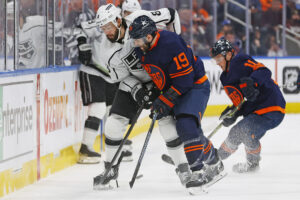On May 11th, 2018, the Toronto Maple Leafs announced that Kyle Dubas would be replacing Lou Lamoriello as general manager of the team. This was announced to be the plan from day one of hiring Lamoriello. Since then, the Leafs have remained a top regular-season team in the NHL. Dubas has made several big splashes since being put in charge of the Leafs. Today, we will review all of his restricted free agent signings.
Reviewing Kyle Dubas’ Time With the Toronto Maple Leafs So Far
Most would agree that Dubas’ work with RFA’s is the worst aspect of his tenure. I’d tend to agree with most people on this. However, I maybe wouldn’t declare him to be an absolute train wreck with it. There are signings where he definitely overpaid, and there are others that came in at fair value. Let’s review these signings.
Note: I will only be reviewing the deals I deem “significant enough” to discuss. I will not be breaking down minor moves.
July 3rd, 2018: Justin Holl
The first relevant RFA signing Dubas made was signing Justin Holl as an RFA. This was a very low-risk signing, but what I liked most about it was the fact that it was two years at $675,000. This let Holl stay signed under an extra year, and he even provided a cap hit below the minimum salary in the second year.
While previous head coach Mike Babcock kept Holl in the press box for most of his tenure, the signing itself was good. As discussed in the UFA article, it was a low-risk/medium reward contract. If Holl plays meaningful minutes for the Leafs? Great! If not? It’s league minimum and can be buried in the AHL.
Grade: B+
December 1st, 2018: William Nylander
I remember this one vividly to this day. #NylanderWatch was trending on Twitter and it was the final day that the Leafs could sign Nylander if he was to play that season. The news came out at 4:59 PM EST that, just four minutes earlier, a contract was submitted to the NHL to extend Nylander. This came after months of near-silence on the Nylander deal. He was signed to a 6-year, $45,000,000 deal. In the first season, his cap hit was $10,277,778 and every subsequent season his cap hit was $6,962,366. This delay worked out, as Kyle Dubas ended up giving Nylander more money. However, he would have a lower cap hit in the last five years, or rather, the important years.
This contract, to many fan’s dismay, is actually a really good deal. It’s likely the best value for the player out of the “Big 4” on the Leafs. The biggest criticism of this negotiation is that it later came out that Nylander would have accepted this contract in September. It seems to be on the Maple Leafs, and more specifically Dubas, that it drew out as long as it did. That’s the biggest knock against this RFA signing.
Grade: B+, A if the same contract had been signed in September
January 13th, 2019: Trevor Moore
It felt like Trevor Moore played a more significant role with the Leafs than he actually did. Dubas signed him to a two-year, $775,000 after a good season in the AHL and a respectable production in the NHL given his role. Moore had some energy in his play that allowed him to help out on the fourth line. He also saw some time on the second line with Tavares (before Moore went down with an injury).
For how much I liked him, Moore never did much with the Leafs. It was a good contract for the player he was. Another depth piece signed to multi-year with low-risk/medium reward. This time, the reward just didn’t really pay off.
Grade: B
February 5th, 2019: Auston Matthews
Here’s the big one (one of two). The Matthews dollar value is great. He’s a truly generational talent. His goal scoring is unmatched in the NHL right now. He’s a top-three player in the league without a doubt. His cap hit of $11,640,250 is absolutely worth it. The issue is the term. Even one additional year would have been more reasonable than the five years he has right now.
This is a player you want on your roster for their entire career. Locking him up for 7 to 8 years should’ve been goal #1 of Kyle Dubas. That’s my biggest gripe with this signing. The cap hit is fair value, he deserves to be in the league’s top-3 highest-paid players.
Grade: B-
March 21st, 2019: Nic Petan
Nic Petan has never really produced in a fourth-line role for the Leafs, but I’d argue he’s been effective in the games he’s drawn in for. Again, signing a league minimum contract carries little to no risk, but with the opportunity to provide upside. Similar to Holl and Moore, Dubas signed this inexpensive contract for two years rather than one. This provides the opportunity for even further upside with little extra risk.
Nic Petan provides solid depth but not much else. He’s a solid player to be your 13th forward or fifth centre. If he’s playing in your regular lineup then there’s an issue. Keeping at league min for two years is a respectable signing.
Grade: B
June 28th, 2019: Kasperi Kapanen & Andreas Johnsson
I did not include the first Johnsson signing on this list because rather than it being a negotiation on Dubas’ part, it was Johnsson accepting his qualifying offer. Kasperi Kapanen and Andreas Johnsson both signed very similar deals ($3.2 and $3.4 million for 3 and 4 years respectively).
These deals were of fair value. At the time I believed they should have used each other as a comparable, and it’s why I’m including them together in this piece. The term was right for both, and the cost is exactly what they should have gotten. A theme with Dubas’ RFAs is that he often signs these players for “fair value”, never really winning any of them from a team perspective.
Grade: B+
July 4th, 2019: Alexander Kerfoot
I also believed Kerfoot to be in the same grouping as Johnsson and Kapanen in terms of historical output and what he should have gotten. For 3.5 for 4 years, he’s right in that same range. Kerfoot saw success with the Avalanche organization, and giving up Nazem Kadri for him, Dubas needed to sign Kerfoot, and sign him for a noticeable amount cheaper than what Kadri was making to make the deal better.
Kerfoot was solid defensively and put up respectable numbers. Getting the Johnsson/Kapanen structure was an understandable deal. Locking up a solid third-line centre. He saw more success in his first season in Toronto than this season, but given his performances, at the time the Kerfoot contract was to be expected.
Grade: B
July 4th, 2019: Cody Ceci
This signing really gets me. Given Ceci’s history, the Leafs should not have been looking to keep him after trading for him. In the best-case scenario, they could have gotten out of keeping Ceci on the roster. Worst case scenario should have been the Leafs could have offered him slightly less than his qualifying offer. Kyle Dubas, rather, gave Ceci $4,500,000. More than his qualifying offer.
Now, Ceci actually had a respectable season defensively with the Leafs. Offensively, he was a bit of a mess. It was absolutely worth getting rid of Zaitsev, but they did not need to keep him and pay him a raise. With his defensive play though, it was better than expected.
Grade: C-
September 13th, 2019: Mitch Marner
I would have had a lot worse things to say about this contract negotiation last year than I do this. Marner has really stepped up this season compared to last. While this contract isn’t as bad as it first seemed, it seems like Dubas got worked on this one. With the Marner camp negotiating through the media, threatening offer-sheets, and other tactics. While I don’t think these tactics scared Dubas, I do think he may have given in too early (he didn’t have the ability to negotiate into the season like Nylander).
The Marner contract was approximately $1,500,000 too much for two years too short in my opinion. That said, it’s not a bad contract, it was just handled poorly and overpaid for a star player. It’s a definite overpayment but it’s better to overpay a star than give a large contract to a Loui Eriksson or Milan Lucic type.
Grade: C
February 12th, 2020: Pierre Engvall
When Kyle Dubas signed Pierre Engvall to 2-years at $1,250,000 per year, I felt it was overblown how bad that it was. Engvall is clearly a fourth-liner that could have potentially helped out on the third line if his upward trend had continued a bit more, but it was a contract that was nearly fully buriable.
While I have thought Engvall has looked decent this season (he’s done some nice work in transition), I foresee him being the first player to be brought out of the lineup when all are healthy, especially considering how well Adam Brooks has played. So while I think anything over $1,000,000 is too much for a 4th liner/13th forward, I don’t think it was detrimental, and a fair bet to make. The bet just hasn’t panned out as well as Dubas had hoped.
Grade: C+
May 14th, 2020: Adam Brooks
Speaking of Adam Brooks, the Leafs sign yet another league min contract for two years. Brooks, on the other hand, has looked fantastic for the Leafs this season. Brooks clearly has the skill (you don’t score 130 points in the WHL without some skill), but he’s been showing it as a fourth-liner of late. He’s really shown that in a limited role.
This is where signing these players to cheap contract to two-year RFA deals rather than one-year begins to pay off. Brooks is 24. He’s getting past “prospect” territory and is just becoming the player he is. Taking a two-year bet on him pays off in this scenario. The Leafs have him locked up for another year under $1,000,000, and if Brooks were to continue playing at his current rate, he could demand a small raise for sure. While I’m not saying he could command multiple millions based on a few NHL games, it’s saving these extra dollars on these deals that help the Leafs navigate paying their top guys so much.
Grade: B+
October 20th, 2020: Ilya Mikheyev
Ilya Mikheyev’s 2019-20 season was a weird one. It was hard to project a deal for the quick skater. He produced excellently at 5v5 through his first half of the season but went down with an injury that ended his regular season shortly following. He had a great year, but how do you price such a small sample size?
Mikheyev’s two-year, $1,645,000 deal looked a lot better the day it was signed than it does today. Mikheyev hasn’t had a great season. But given the information at the time, and the short length of the deal, it’s not as bad as GMs of Leaf’s past have done. He’s overpaid based on his current performance, but we’ve seen that Mikheyev does have the ability to play well, like in 2019-20. If he finds that footing again, this deal could turn around quickly.
Grade: B
October 23rd, 2020: Travis Dermott
I thought Travis Dermott had a fantastic 2019-20 season. The fact that Dubas kept him for under $1,000,000 after that season was very impressive. Sure, he was a third-pair defender. But he certainly played better than his position.
With all that said, I feel like Dermott has taken a bit of a step back this season. I do feel like Dermott is a better defenceman than his on-ice results would suggest this season, but since Kyle Dubas added some key defensive pieces (and got rid of others), he hasn’t needed to be great on the bottom pair thus far. If he finds his footing for the last few games of the season and the playoffs, my outlook could be VERY good for this contract.
Grade: A-
Overall
Overall, this is no doubt Kyle Dubas’ worst aspect of his GMing. I don’t think it’s as bad as some would suggest (many make it out to be he’s among the worst in the league). But his biggest issues came with key players like Marner’s cap hit, Matthews’ term and Nylander’s hold out. At best, Dubas has seemed to get fair value. There have been no major wins, but he also hasn’t given any serious money to a bad player yet.
Special thanks to CapFriendly for providing all data on the contracts and signings.
Main photo:
Embed from Getty Images






